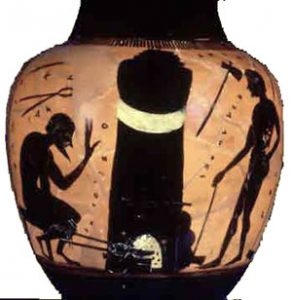
History of iron: a Greek black-figure vase showing a blacksmith at work (Athens, about 550 BC)
Why do people use iron?
The history of iron doesn’t start until much later than bronze. Iron is harder to form into metal than copper or bronze, because it needs a much hotter fire and a more complicated process.
What is iron?
History of bronze
West Asian science
All our West Asia articles
But if you can figure out how to do it, iron is also much more useful than copper or bronze. Also, iron is very common all over the world, so everyone can get it cheaply.
You need to use a bellows
Here’s an Ancient Greek vase showing a blacksmith heating up a furnace to smelt iron ore into iron. A younger boy works the bellows to blow the fire hot enough.
Invention of the bellows
Below, there’s a video of a blacksmith making something out of iron. First he heats up the metal so it will get softer, and then he beats it into shape with a hammer. Nobody could work iron until they figured out how to build a bellows to get their fires hot enough.
Blacksmith at work
The Hittites figure out how to make iron
Because iron is so hard to make, nobody used iron before about 1500 BC. Then the Hittites in West Asia did learn how to use it. Once people had these hotter fires, they also started to make more glass.
Who were the Hittites?
Who invented glass?
Iron reaches China, Vietnam, and West Africa
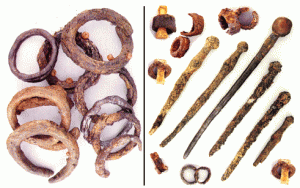
Hittite iron bracelets and pins from what is now Turkey, about 1200-1100 BC
Gradually all the West Asian and Mediterranean people started to use iron: the Greeks, the Egyptians, the Kushites, the Jews, the Philistines, the Romans, the Carthaginians, and the Assyrians. Iron-working travelled east, too, reaching India around 800 BC.
People who lived in China learned how to make iron by around 700 or 600 BC, during the Eastern Zhou dynasty. Iron quickly spread to Laos, too. By 300 BC, smiths were using iron in Vietnam. And iron-workers in Greece were burning coal to get hotter fires.
History of coal
By about 300 AD, people in West Africa and East Africa had also learned the secrets of making iron. Some people think they learned how from the Egyptians; other people think the Africans figured it out on their own. Since then, iron has been the metal people use most all over Afro-Eurasia.
History of iron: what did people use iron for?

Broken clay crucible for making steel, from Chahak, Iran
Not only was iron cheaper and easier to get than bronze, it also made better tools. With an iron sword, you could slice as well as stabbing with the point. Iron armor was lighter and stronger than bronze. So Iron knives and scissors were sharper than bronze ones and stayed sharp longer.
Iron fish-hooks were stronger and lighter and sharper than bronze or bone hooks. Iron cooking pots weighed less, got hot faster, and held heat better than clay pots. And iron bars were stronger and could hold more weight. In India, by the 1000s AD architects were even making iron beams to hold up the roofs of big temples.
India and Central Asia: making iron into steel
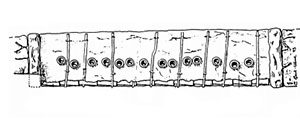
Steel furnace from Samanalawewa, Sri Lanka
But people didn’t stop with just inventing iron. Not long after people started using iron in Central Asia, they improved on it by inventing steel. Steel is iron with extra carbon in it. Around 300 BC, people began to make high quality steel in India and in Central Asia (modern Uzbekistan and Afghanistan). Steel swords were stronger and sharper.
Steel sewing needles were thinner and sharper, too. With steel needles, people started to sew clothes more instead of just wrapping pieces of cloth around themselves. Central Asians and Indians started to sell their steel to West Asia and China along the Silk Road. Indian steel manufacturers were buying high quality iron ore from Central Africa, carried on river boats to ports along the coast of East Africa, so they could make higher quality steel. By the 800s AD, the Vikings were making the long trip south-east from northern Europe through Russia to buy Central Asian steel, too.
More about sewing needles
And about the Vikings
Did you find out what you wanted to know about the history of iron and blacksmithing? Let us know in the comments!


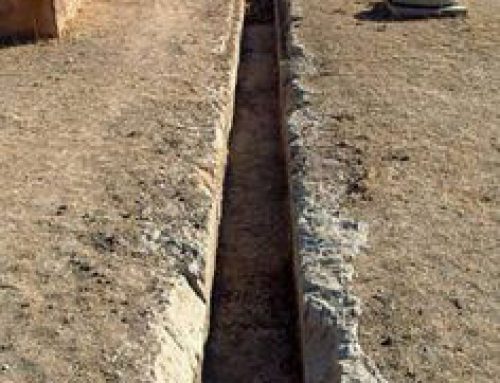
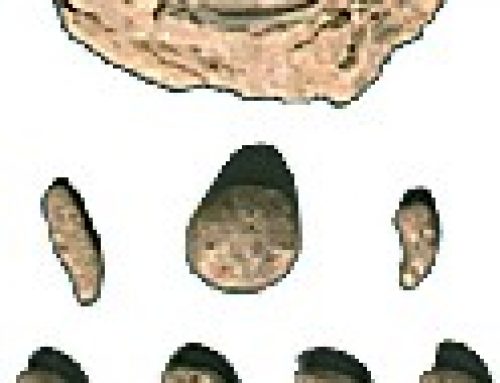

When you say teel in the 2nd paragraph of “India and Central Asia: making iron into steel”. Did you mean steel or did you mean to use teel.
Oh, thanks for pointing that out. I’ve fixed it now.
Would Iron be used for anything else during the 1600s?
And thank you for the great article.
I’m glad you liked it! Yes, by the 1600s people were using steel (a kind of iron) to make the little parts of mechanical clocks. That’s important because you needed accurate clocks to keep track of where you were on a ship at sea. People were also making more and more machinery out of iron, like knitting machines.
who is the publisher
Quatr.us Study Guides is the publisher.
I have a question about the validity of the Hittites creating the process of making iron. India also claims to have created iron around the same time frame 1500bc. They have more archeological evidence than Syria does. So what makes the difference when citing the Hittites over the Indian culture?
Garey Knoles
Cartography major at East Central University
Senior Research Project is “The Diffusion of Blacksmithing”
What is the evidence for iron-working from 1500 BC in India? I am not aware of it, but would be happy to see it. India takes the lead in steel-working in the 300s BC, though. You can read our article about that here: https://quatr.us/india/steel-ancient-medieval-steel.htm . I would place the Hittites in what is now Turkey, not Syria.
no information about when they started it
It’s not right at the beginning of the article, but it’s in there.
This doesn’t tell me what they made
Yes, it does. Look at the 6th paragraph.
Thank you very much !
You’re welcome! Thanks for stopping by!